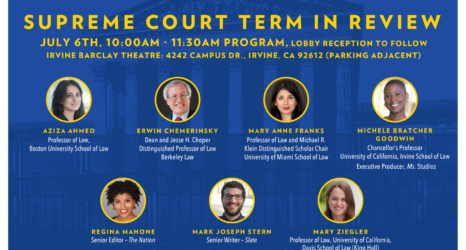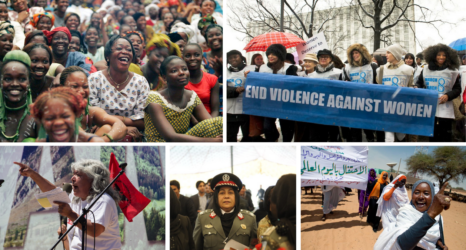
On August 18, 1920, Tennessee became the 36th and final state required to ratify the 19th Amendment, declaring “the right of citizens of the United States to vote shall not be denied or abridged by the United States or by any State on account of sex.”
The suffrage amendment capped a century of creative, courageous and continual activism by women to achieve the vote.
To celebrate the centennial anniversary of the suffrage amendment, the Natural History Museum of Los Angeles County opened a new digital exhibit—”Rise Up LA: A Century of Votes for Women”—on August 18.
The online exhibition includes a three-part virtual discussion series, “When Women Vote,” co-sponsored with Zócalo Public Square (an ASU Knowledge Enterprise).
The virtual discussion series is organized around three questions:
- How Have Women’s Protests Changed History?: AUGUST 20, 2020 | THURSDAY | 6 p.m. PDT
- Why Don’t Women’s Votes Put More Women in Power?: SEPTEMBER 16, 2020 | WEDNESDAY | 6:00 p.m. PDT
- What Are Today’s L.A. Women Fighting For?: DECEMBER 3, 2020 | THURSDAY | 6 p.m. PDT
“One hundred years ago women demonstrated their power to effect political and societal change, and women are again on the frontlines of protest and on the precipice of making history,” said Moira Shourie, executive director of Zócalo Public Square. “This is an important moment to create a space to broaden this dialogue and document this movement in real time.”
How Have Women’s Protests Changed History?
The first event on Thursday, Aug. 20, will feature USC labor historian Francille Rusan Wilson, Northeastern University feminist sociologist Valentine Moghadam, and UCLA gender studies professor Ju Hui Judy Han to discuss the power of women saying “no” throughout history:
“There are few forces of nature more formidable than a group of women fed up with the status quo. From the French Revolution—which was sparked in part by a 7,000-woman march from Paris to Versailles—to Black Lives Matter—which was founded by three queer Black women—some of the most important protest movements in global history have been women-led.
“In addition to organizing many of summer 2020’s continuing marches, over the past century women have taken to the streets to rally for voting and equal rights, to condemn sexual and gun violence, and to stand against the sitting president. But protest has taken other forms too, including the #MeToo movement, anti-colonial mobilizations from Ethiopia to Southeast Asia, women taking the wheel in Saudi Arabia to demand the right to drive, and boycotts and strikes like the Women’s Political Council Montgomery bus boycott.
“How have women risen up collectively to create change—and influenced broader movements in the process? What has made women particularly effective protesters, and what ideas have women come up with that have changed the art of protest?”
These free events will be live streamed with a moderated live chat in real time. Register online here.
In addition to the discussion series, the Natural History Museum’s online exhibition has historical ephemera, including buttons; interactive activities like voting on measures from California’s 1920 fall ballot and comparing their answers to the 1920 results; at-home activities from sign-making to a DIY Oral Story interview; and instructions on registering to vote in the 2020 elections.

The exhibit honors 100 years of passion and progress through narratives about everyday women who shaped the political landscape through voting, community organizing, and fighting for rights in the workplace, classroom and community from the turn of the century through the current moment.
The exhibit had a video premiere as well—”Rise Up LA: Voices of the Women’s Movement”—on August 18 at 6 p.m., drawing from NHM’s Oral Stories Project. (Watch it below.)
The Project interviewed 30 LA women over the age of 65 with diverse backgrounds and interests on how gender equity and activism has grown and changed, both in terms of personal experiences and as a national and global movement, in these women’s lifetimes.
“Within the national context of women’s right to vote, Los Angeles has a particularly compelling story and many of our current civic leaders have played a critical role in fighting for equality for decades,” says Dr. Lori Bettison-Varga, President and Director of the Natural History Museum.
From the Women’s March on Versailles of 1789 to the founders of the Black Lives Matter movement today, women have been on the front lines of social and political movements for centuries. This exhibition and discussion series will explore how women have risen up collectively to create change and influence broader movements in the process, what has made women particularly effective protesters, and how women have changed the art of protest.
Ms. spoke further with Dr. Bettison-Varga and Moira Shourie, executive director of Zócalo Public Square, to share their insights on the significance of the “When Women Vote” project.
Ms.: The three topics for the streaming events are “How Have Women’s Protests Changed History?”, Why Don’t Women’s Votes Put More Women in Power?” and “What Are Today’s L.A. Women Fighting For?” How were these three topics decided on?
Moira Shourie: At Zócalo we try to anchor current events in a historical foundation, and try to explain why the world is the way it is. With the “When Women Vote” series, we decided to start broadly and redefine our frame with each subsequent topic. We open the series with a global analysis of women’s protests, we will examine uprisings in the Middle East, China, Korea and across the US.
Then we will drill down one level deeper to examine the national correlation between US women’s voting patterns and representation in political power.
Finally, we will focus specifically on Los Angeles. Not just because it’s our hometown, but also because it’s the largest minority-majority city in the U.S. We aim to cover specific LA issues like housing affordability, policing, labor, incarceration, education, healthcare and the environment.
Ms.: Although the 19th amendment was passed in 1920, it would still be decades before Black women formally obtained the right to vote following the Voting Rights Act of 1965.
However, since then the Voting Rights Act has been gutted, voter suppression continues, and President Trump admitted to blocking funding for the Postal Service to prevent mail-in voting. What advice do you have for people who feel disillusioned about the state of voting rights in the U.S.?
Shourie: To look forward we have to look back and see what pioneering leaders, mostly women, did to secure these rights for us. My advice to those feeling disillusioned is Don’t Give Up … Go vote because, truly, your life and the lives of your loved ones depends on it. If your right to vote has been taken from you, or never granted to you, use your voice. Speak up! We fight so doggedly for our freedoms, but we have lost sight of hard work that sustains our democracy.
Ms.: Last week, former Vice President Joe Biden announced Sen. Kamala Harris as his running mate. For the first time, a Black woman has been nominated as the vice president on a major party ticket. What could this milestone mean for the future of American democracy?
Shourie: I am a new American citizen, sworn in in 2017. I left one democratic framework—the largest democracy in the world—India … and joined the most powerful democracy in the world—the United States of America.
Kamala Harris represents the real face of America. We are not defined by just one thing—race, political affiliations, gender, academic degrees, income. And so the people that occupy the seats of power should also represent the many sides of American citizenry.
Every one of us is a person with dimensions, and the selection of a Black woman demonstrates that the corridors and doorways of power have been flung open again. It demonstrates that political power is no longer the domain of a single race and gender.
Ms.: The event’s press release says, “Los Angeles has a particularly compelling story and many of our current civic leaders have played a critical role in fighting for equality for decades.” Could you give our readers a quick rundown of the importance of Los Angeles’s history in the broader fight for equality?
Dr. Lori Bettison-Varga: By 1920, Los Angeles was the only Western city where women outnumbered men. They lived lives that, at the time, would have been considered daring: nearly one in five were widowed or divorced; many found jobs outside the home and worked after the age of 25.
In the 1930s and 40s, women entered the workforce in Los Angeles in unprecedented numbers—one prime example is the Latina dressmakers in Los Angeles forming International Ladies’ Garment Workers’ Union (ILGWU) local in 1933—and in the following decades shaped conversations around workplace equality and equal pay for equal work.
In the 1960s and 70s, women in Los Angeles took lead in organizing on behalf of the National Organization for Women (NOW), the Gay Liberation Front and The Women’s Center, for Chicana rights as part of Poder Feminino and the Brown Berets, the main newspaper of the Asian Power movement, Gidra, and fighting for school desegregation and civil rights as part of NAACP and CORE. The last thirty years have increasingly seen women in leadership roles within Los Angeles city government.
In 1991, Gloria Molina became the first Latina on the Los Angeles County Board of Supervisors and presently women currently hold four of the five seats on the Los Angeles County Board of Supervisors and for the first time, the city’s 41 boards and commissions had roughly the same number of women as men—the gender balance in Los Angeles politics is finally changing.
Ms.: With the pandemic, many museums are moving to virtual exhibitions and live-streaming events to accommodate guests. What do you see as the biggest challenge in curating a virtual exhibit?
Bettison-Varga: We are learning about what is most compelling in a virtual environment as well as what unique opportunities there are to explore. It has also allowed a different set of creative team members shine! For example, geolocating a specimen is great, zoom in features in the photography.
Ms.: Are there any benefits to having virtual exhibits that may not be obvious at first glance?
Bettison-Varga: A virtual exhibition can be accessed anywhere in the world and not bound by the physical location. Virtual exhibitions allow you to stay with the content (videos, audio and photographs) longer and access both the exhibit and support resources at any time. In some cases, it allows you to get closer to an object or specimen as it is tied to dynamic data points and brings in audience responses through polling, social media or community comment . There is more flexibility in adding or changing language to make it bi-lingual or in the future, multilingual.
Virtual exhibitions allow for audience engagement during closure as well as engagement activities that extend and activate the content from the comfort of your own home.
Ms.: What is a key takeaway you hope guests will come away with after viewing the exhibit and tuning into the live streams?
Bettison-Varga: Women have been at the forefront of issues that challenge our foundations to address what makes a society better such as education, equal pay, environmental justice and a sense of community. It is incumbent on all Americans to fight for the right of every citizen to vote, and to exercise the right to vote—a fundamental principle of our democracy.





